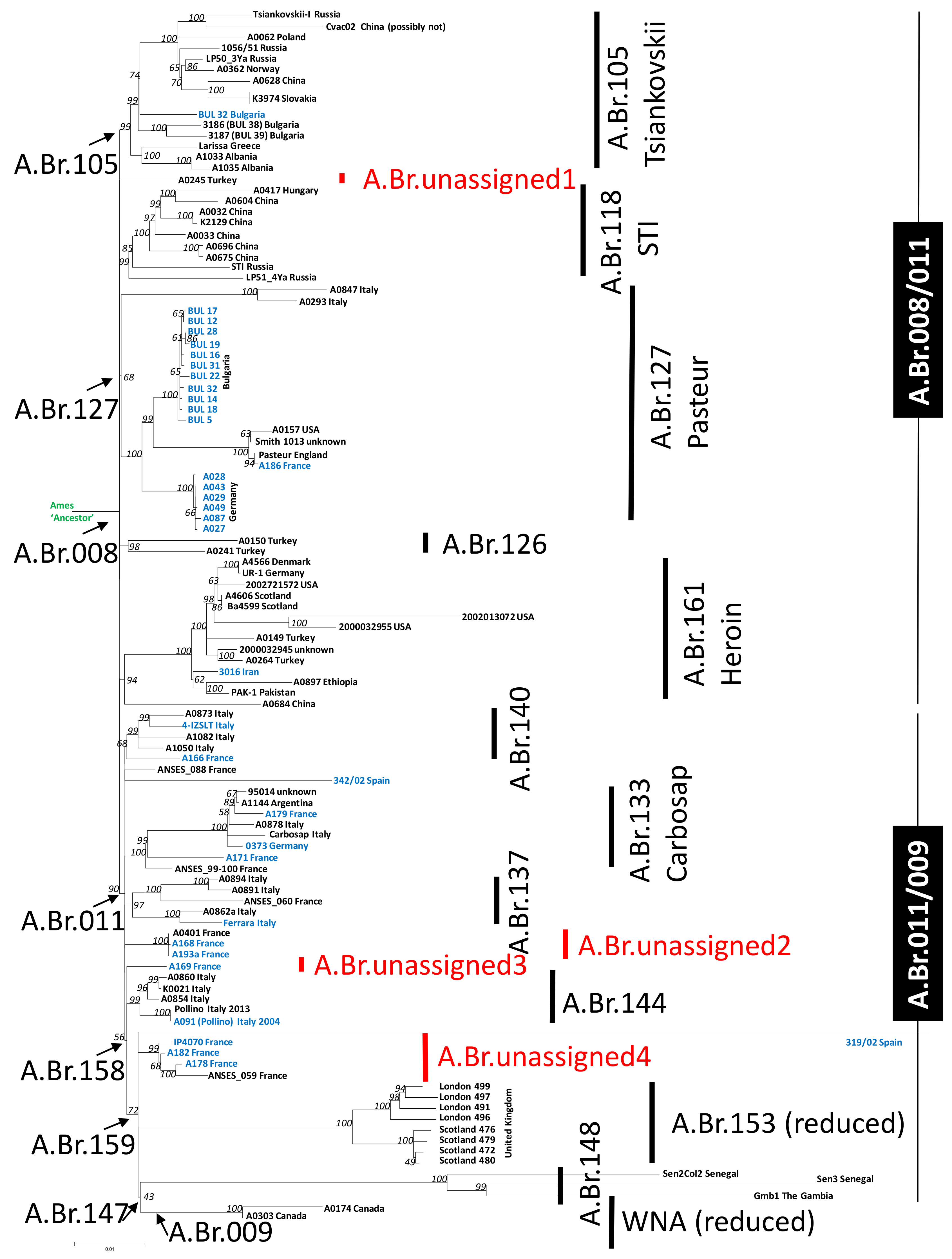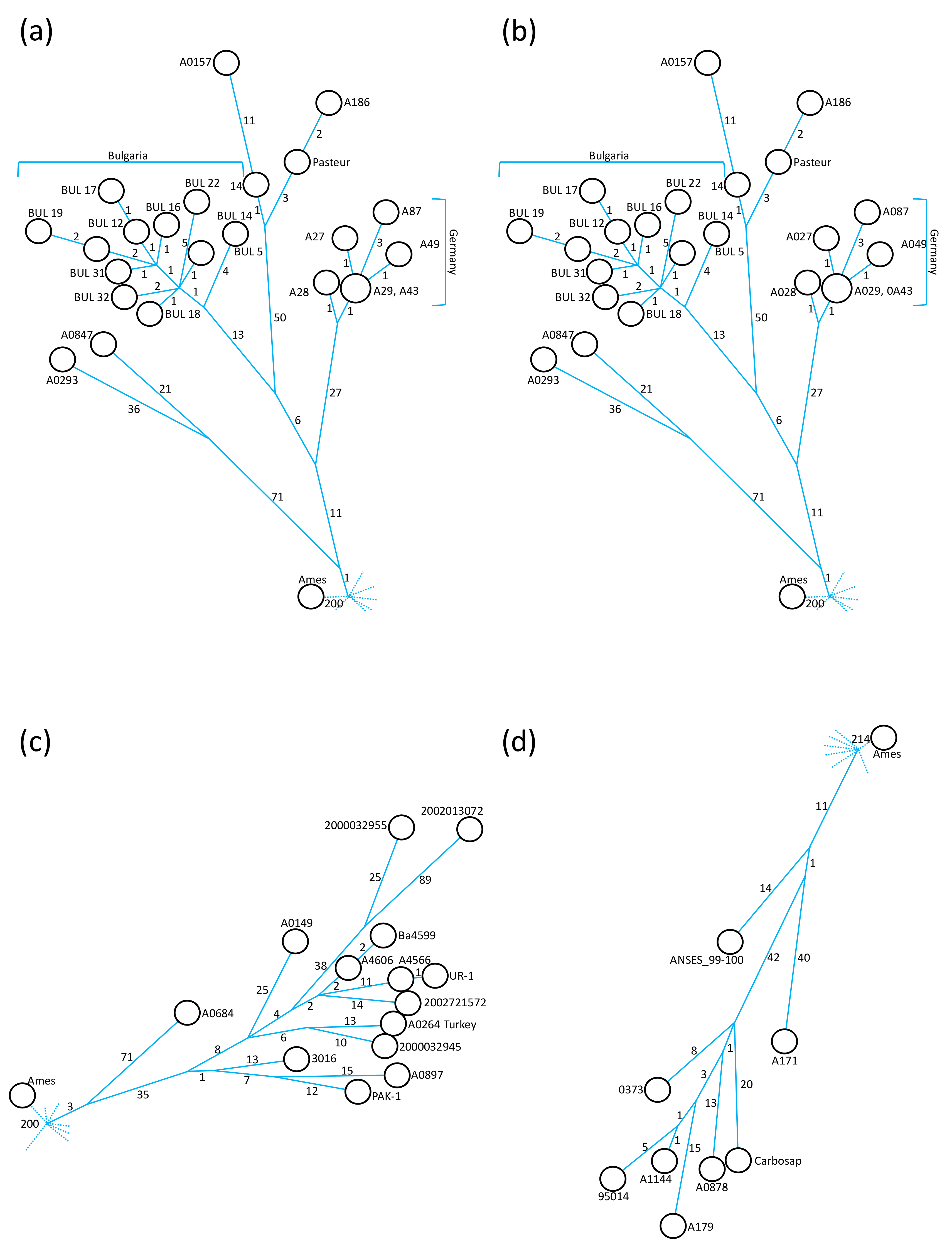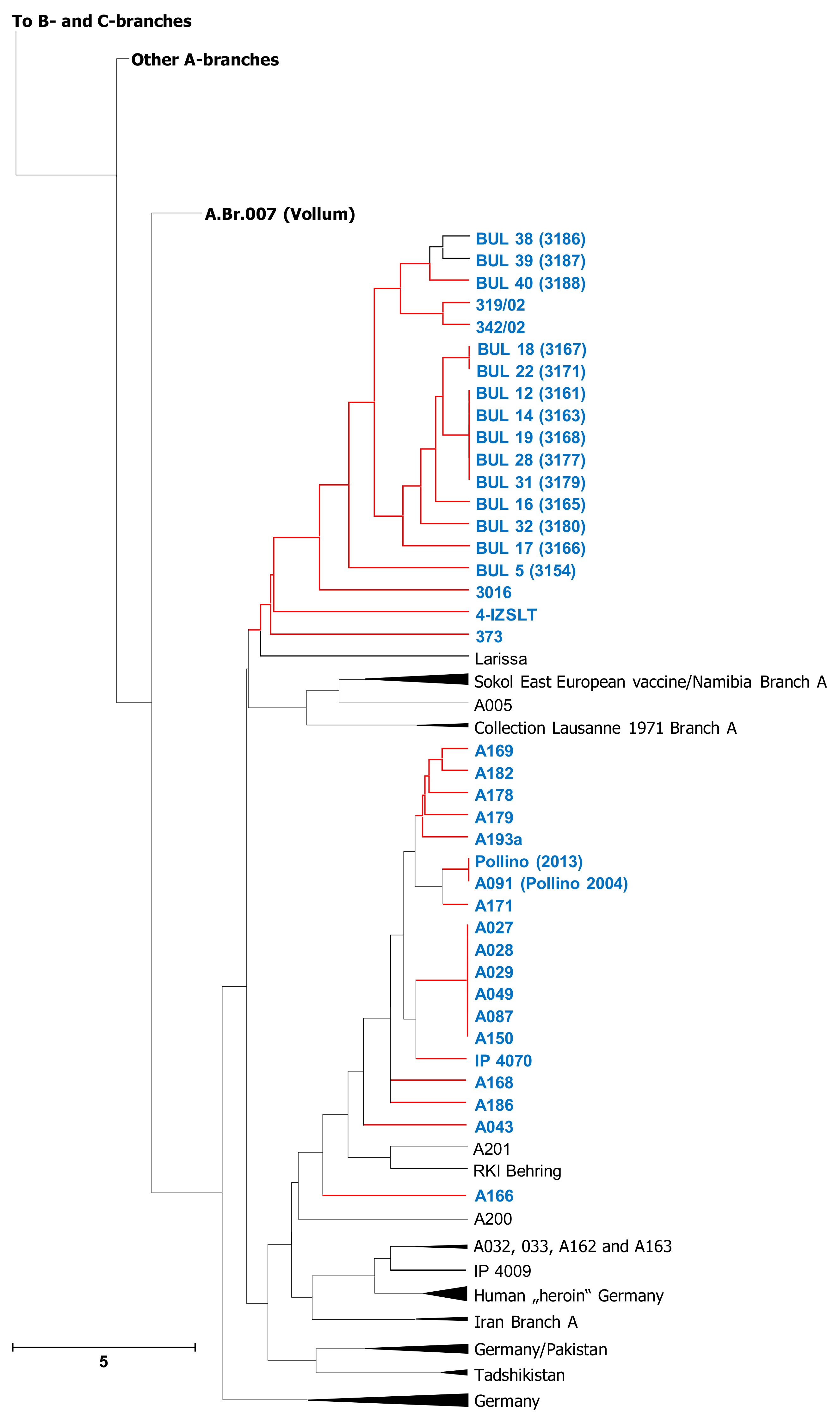Phylogenetic Placement of Isolates Within the Trans-Eurasian Clade A.Br.008/009 of Bacillus anthracis
Abstract
1. Introduction
2. Materials and Methods
2.1. Growth of B. anthracis and Extraction of DNA from Inactivated Culture Material
2.2. Whole Genome Sequencing
2.3. Analysis of Whole Genome Sequencing Data–SNP Calling
2.4. Interrogation of SNPs via PCR by Relative Ct-Value Analysis (Delayed Mismatch Amplification Assay, DMAA)
2.5. Multi Locus VNTR (Variable Number of Tandem Repeats) Analysis (MLVA)
3. Results and Discussion
3.1. Assignment of Newly Sequenced Strains to canSNP Groups of B. anthracis
3.2. Relationships of Newly Sequenced Strains Within canSNP Groups Sub-Lineages of B. anthracis
3.3. Relationships of Newly Sequenced B. anthracis Strains Drawn From MLVA Typing
3.4. New SNP-PCR Discriminating Assays for Phylogenetic Placement of Additional A.Br.008/009 Clade Strains of B. anthracis
Supplementary Materials
Author Contributions
Funding
Acknowledgments
Conflicts of Interest
References
- WHO. World Health Organization Anthrax in Humans and Animals, 4th ed.; WHO Press: Geneva, Switzerland, 2008. [Google Scholar]
- Blackburn, J.K.; McNyset, K.M.; Curtis, A.; Hugh-Jones, M.E. Modeling the geographic distribution of Bacillus anthracis the causative agent of anthrax disease, for the contiguous United States using predictive ecological niche modeling. Am. J. Trop. Med. Hyg. 2007, 77, 1103–1110. [Google Scholar] [CrossRef] [PubMed]
- Barro, A.S.; Fegan, M.; Moloney, B.; Porter, K.; Muller, J.; Warner, S.; Blackburn, J.K. Redefining the Australian anthrax belt: Modeling the ecological niche and predicting the geographic distribution of Bacillus anthracis. PLoS Negl. Trop. Dis. 2016, 10, e0004689. [Google Scholar] [CrossRef] [PubMed]
- Lienemann, T.; Beyer, W.; Pelkola, K.; Rossow, H.; Rehn, A.; Antwerpen, M.; Grass, G. Genotyping and phylogenetic placement of Bacillus anthracis isolates from Finland, a country with rare anthrax cases. BMC Microbiol. 2018, 18, 102. [Google Scholar] [CrossRef] [PubMed]
- Ågren, J.; Finn, M.; Bengtsson, B.; Segerman, B. Microevolution during an anthrax outbreak leading to clonal heterogeneity and penicillin resistance. PLoS ONE 2014, 9, e89112. [Google Scholar] [CrossRef]
- Antwerpen, M.; Elschner, M.; Gaede, W.; Schliephake, A.; Grass, G.; Tomaso, H. Genome sequence of Bacillus anthracis strain Stendal, isolated from an anthrax outbreak in cattle in Germany. Genome Announc. 2016, 4, e00219-16. [Google Scholar] [CrossRef]
- Manzulli, V.; Fasanella, A.; Parisi, A.; Serrecchia, L.; Donatiello, A.; Rondinone, V.; Caruso, M.; Zange, S.; Tscherne, A.; Decaro, N.; et al. Evaluation of in vitro antimicrobial susceptibility of Bacillus anthracis strains isolated during anthrax outbreaks in Italy from 1984 to 2017. J. Vet. Sci. 2019, 20, 58–62. [Google Scholar] [CrossRef]
- Vergnaud, G.; Girault, G.; Thierry, S.; Pourcel, C.; Madani, N.; Blouin, Y. Comparison of French and worldwide Bacillus anthracis strains favors a recent, post-Columbian origin of the predominant North-American clade. PLoS ONE 2016, 11, e0146216. [Google Scholar] [CrossRef]
- Van Ert, M.N.; Easterday, W.R.; Huynh, L.Y.; Okinaka, R.T.; Hugh-Jones, M.E.; Ravel, J.; Zanecki, S.R.; Pearson, T.; Simonson, T.S.; U’Ren, J.M.; et al. Global genetic population structure of Bacillus anthracis. PLoS ONE 2007, 2, e461. [Google Scholar] [CrossRef]
- Antwerpen, M.; Ilin, D.; Georgieva, E.; Meyer, H.; Savov, E.; Frangoulidis, D. MLVA and SNP analysis identified a unique genetic cluster in Bulgarian Bacillus anthracis strains. Eur. J. Clin. Microbiol. Infect. Dis. 2011, 30, 923–930. [Google Scholar] [CrossRef]
- Pullan, S.T.; Pearson, T.R.; Latham, J.; Mason, J.; Atkinson, B.; Silman, N.J.; Marston, C.K.; Sahl, J.W.; Birdsell, D.; Hoffmaster, A.R.; et al. Whole-genome sequencing investigation of animal-skin-drum-associated UK anthrax cases reveals evidence of mixed populations and relatedness to a US case. Microb. Genom. 2015, 1, e000039. [Google Scholar] [CrossRef]
- Sahl, J.W.; Pearson, T.; Okinaka, R.; Schupp, J.M.; Gillece, J.D.; Heaton, H.; Birdsell, D.; Hepp, C.; Fofanov, V.; Noseda, R.; et al. Bacillus anthracis genome sequence from the Sverdlovsk 1979 autopsy specimens. mBio 2016, 7, e01501–01516. [Google Scholar] [CrossRef] [PubMed]
- Braun, P.; Grass, G.; Aceti, A.; Serrecchia, L.; Affuso, A.; Marino, L.; Grimaldi, S.; Pagano, S.; Hanczaruk, M.; Georgi, E.; et al. Fasanella A Microevolution of anthrax from a young ancestor (MAYA) suggests a soil-borne life cycle of Bacillus anthracis. PLoS ONE 2015, 10, e0135346. [Google Scholar] [CrossRef] [PubMed]
- Bankevich, A.; Nurk, S.; Antipov, D.; Gurevich, A.A.; Dvorkin, M.; Kulikov, A.S.; Lesin, V.M.; Nikolenko, S.I.; Pham, S.; Prjibelski, A.D.; et al. Pevzner PA SPAdes: A new genome assembly algorithm and its applications to single-cell sequencing. J. Comput. Biol. 2012, 19, 455–477. [Google Scholar] [CrossRef] [PubMed]
- Walker, B.J.; Abeel, T.; Shea, T.; Priest, M.; Abouelliel, A.; Sakthikumar, S.; Cuomo, C.A.; Zeng, Q.; Wortman , J.; Young, S.K.; et al. Pilon: An integrated tool for comprehensive microbial variant detection and genome assembly improvement. PLoS ONE 2014, 9, e112963. [Google Scholar]
- Angiuoli, S.V.; Gussman, A.; Klimke, W.; Cochrane, G.; Field, D.; Garrity, G.; Kodira, C.D.; Kyrpides, N.; Madupu, R.; Markowitz, V.; et al. Toward an online repository of Standard Operating Procedures (SOPs) for (meta)genomic annotation. OMICS 2008, 12, 137–141. [Google Scholar] [CrossRef]
- Treangen, T.J.; Ondov, B.D.; Koren, S.; Phillippy, A.M. The Harvest suite for rapid core-genome alignment and visualization of thousands of intraspecific microbial genomes. Genome Biol. 2014, 15, 524. [Google Scholar] [CrossRef]
- Tamura, K.; Nei, M. Estimation of the number of nucleotide substitutions in the control region of mitochondrial DNA in humans and chimpanzees. Mol. Biol. Evol. 1993, 10, 512–526. [Google Scholar]
- Kumar, S.; Stecher, G.; Tamura, K. MEGA7: Molecular Evolutionary Genetics Analysis version 7.0 for bigger datasets. Mol. Biol. Evol. 2016, 33, 1870–1874. [Google Scholar] [CrossRef]
- Birdsell, D.N.; Pearson, T.; Price, E.P.; Hornstra, H.M.; Nera, R.D.; Stone, N.; Gruendike, J.; Kaufman, E.L.; Pettus, A.H.; Hurbon, A.N.; et al. Melt analysis of mismatch amplification mutation assays (Melt-MAMA): A functional study of a cost-effective SNP genotyping assay in bacterial models. PLoS ONE 2012, 7, e32866. [Google Scholar] [CrossRef]
- Kreizinger, Z.; Sulyok, K.M.; Makrai, L.; Ronai, Z.; Fodor, L.; Janosi, S.; Gyuranecz, M. Antimicrobial susceptibility of Bacillus anthracis strains from Hungary. Acta Vet. Hung. 2016, 64, 141–147. [Google Scholar] [CrossRef]
- Newton, C.R.; Graham, A.; Heptinstall, L.E.; Powell, S.J.; Summers, C.; Kalsheker, N.; Smith, J.C.; Markham, A.F. Analysis of any point mutation in DNA. The amplification refractory mutation system (ARMS). Nucleic Acids Res. 1989, 17, 2503–2516. [Google Scholar] [CrossRef] [PubMed]
- Ye, J.; Coulouris, G.; Zaretskaya, I.; Cutcutache, I.; Rozen, S.; Madden, T.L. Primer-BLAST: A tool to design target-specific primers for polymerase chain reaction. BMC Bioinform. 2012, 13, 134. [Google Scholar] [CrossRef] [PubMed]
- Beyer, W.; Bellan, S.; Eberle, G.; Ganz, H.H.; Getz, W.M.; Haumacher, R.; Hilss, K.A.; Kilian, W.; Lazak, J.; Turner, W.C.; et al. Distribution and molecular evolution of Bacillus anthracis genotypes in Namibia. PLoS Negl. Trop. Dis. 2012, 6, e1534. [Google Scholar] [CrossRef] [PubMed]
- Bassy, O.; Jimenez-Mateo, O.; Ortega, M.V.; Granja, C.; Cabria, J.C. Rapid identification of Bacillus anthracis by real-time PCR with dual hybridization probes in environmental swabs. Mol. Cell. Probes 2018, 37, 22–27. [Google Scholar] [CrossRef]
- Pisarenko, S.V.; Eremenko, E.I.; Ryazanova, A.G.; Kovalev, D.A.; Buravtseva, N.P.; Aksenova, L.Y.; Evchenko, A.Y.; Semenova, O.V.; Bobrisheva, O.V.; Kuznetsova, I.V.; et al. Genotyping and phylogenetic location of one clinical isolate of Bacillus anthracis isolated from a human in Russia. BMC Microbiol. 2019, 19, 165. [Google Scholar] [CrossRef]
- Keim, P.; Grunow, R.; Vipond, R.; Grass, G.; Hoffmaster, A.; Birdsell, D.N.; Klee, S.R.; Pullan, S.; Antwerpen, M.; Bayer, B.N.; et al. Whole genome analysis of injectional anthrax identifies two disease clusters spanning more than 13 years. EBioMedicine 2015, 2, 1613–1618. [Google Scholar] [CrossRef]
- Estoup, A.; Jarne, P.; Cornuet, J.M. Homoplasy and mutation model at microsatellite loci and their consequences for population genetics analysis. Mol. Ecol. 2002, 11, 1591–1604. [Google Scholar] [CrossRef]
- Nadon, C.; Van Walle, I.; Gerner-Smidt, P.; Campos, J.; Chinen, I.; Concepcion-Acevedo, J.; Gilpin, B.; Smith, A.M.; Man Kam, K.; Perez, E.; et al. PulseNet International: Vision for the implementation of whole genome sequencing (WGS) for global food-borne disease surveillance. EuroSurveillance 2017, 22, 30544. [Google Scholar] [CrossRef]
- Fortini, D.; Ciammaruconi, A.; De Santis, R.; Fasanella, A.; Battisti, A.; D’Amelio, R.; Lista, F.; Cassone, A. Carattoli A Optimization of high-resolution melting analysis for low-cost and rapid screening of allelic variants of Bacillus anthracis by multiple-locus variable-number tandem repeat analysis. Clin. Chem. 2007, 53, 1377–1380. [Google Scholar] [CrossRef]



| SNP Designation | # of Strains | Origin (Year of Isolation) |
|---|---|---|
| A.Br.1051 (Tsiankovskii) | 4 | Germany (unknown), Switzerland (unknown), Bulgaria (1960–1980), Namibia (unknown) |
| A.Br.118 (STI) 1 | 3 | Russia (1991), 2 × Russia (unknown) |
| A.Br.127 (Pasteur) 1 | 1 | France (1996) |
| A.Br.Pasteur-GER | 0 | / |
| A.Br.Pasteur-BUL | 13 | Bulgaria (1960–1980) |
| A.Br.133 (Carbosap) 1 | 0 | / |
| A.Br.NN4 | 0 | / |
| A.Br.140 1 | 0 | / |
| A.Br.147 1 | 11 | 9 x Bulgaria (1960–1980), Germany (2007), Canada (unknown) |
© 2019 by the authors. Licensee MDPI, Basel, Switzerland. This article is an open access article distributed under the terms and conditions of the Creative Commons Attribution (CC BY) license (http://creativecommons.org/licenses/by/4.0/).
Share and Cite
Antwerpen, M.; Beyer, W.; Bassy, O.; Ortega-García, M.V.; Cabria-Ramos, J.C.; Grass, G.; Wölfel, R. Phylogenetic Placement of Isolates Within the Trans-Eurasian Clade A.Br.008/009 of Bacillus anthracis. Microorganisms 2019, 7, 689. https://doi.org/10.3390/microorganisms7120689
Antwerpen M, Beyer W, Bassy O, Ortega-García MV, Cabria-Ramos JC, Grass G, Wölfel R. Phylogenetic Placement of Isolates Within the Trans-Eurasian Clade A.Br.008/009 of Bacillus anthracis. Microorganisms. 2019; 7(12):689. https://doi.org/10.3390/microorganisms7120689
Chicago/Turabian StyleAntwerpen, Markus, Wolfgang Beyer, Olga Bassy, María Victoria Ortega-García, Juan Carlos Cabria-Ramos, Gregor Grass, and Roman Wölfel. 2019. "Phylogenetic Placement of Isolates Within the Trans-Eurasian Clade A.Br.008/009 of Bacillus anthracis" Microorganisms 7, no. 12: 689. https://doi.org/10.3390/microorganisms7120689
APA StyleAntwerpen, M., Beyer, W., Bassy, O., Ortega-García, M. V., Cabria-Ramos, J. C., Grass, G., & Wölfel, R. (2019). Phylogenetic Placement of Isolates Within the Trans-Eurasian Clade A.Br.008/009 of Bacillus anthracis. Microorganisms, 7(12), 689. https://doi.org/10.3390/microorganisms7120689






